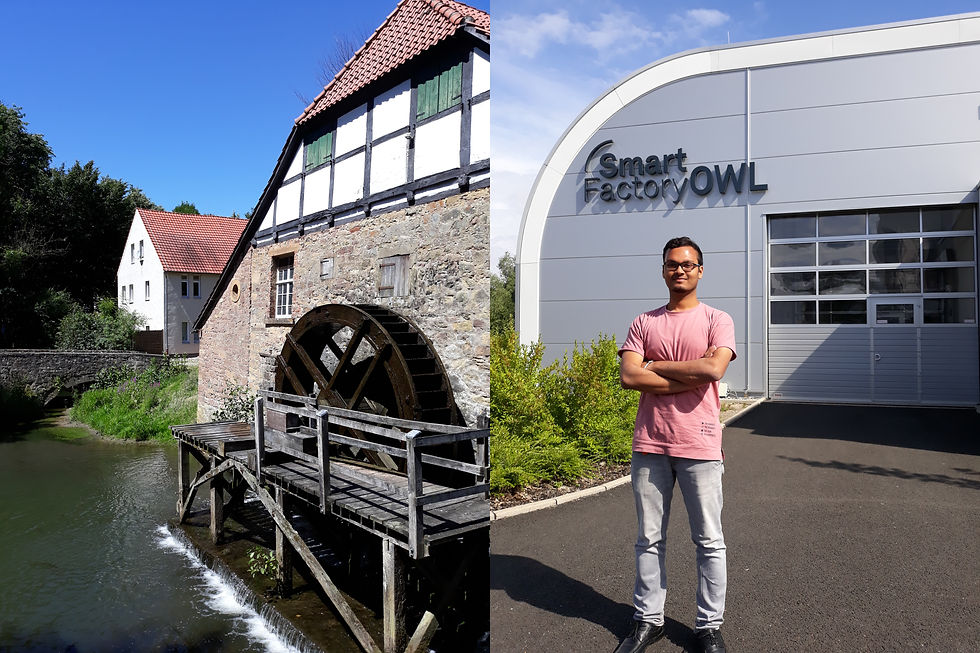212 years of industrial evolution by a 10% me.
- ankurashutosh
- Oct 18, 2018
- 4 min read
Updated: Jun 10, 2019
A brief note on industries: My experience as an intern in Germany...

It really intrigues me to see how we started with the ancient water wheel as one of the earliest factories, and how the evolutionary process through the centuries has enabled us to envision SmartFactories in near future.
It is this fascination of mine and probably some of you, the machine lovers type, that I want to share with you in the form of my tryst with two places during my recent internship (after junior year in Mechanical Engg.) in Lemgo, Germany; ‘Water-wheel oil mill of Schloss Brake, 1806’ and the SmartFactory OWL as in 2018, thus, me covering 212 years of industrial evolution with an age nearly one-tenth of this time span!!
Although water wheels and other similar inventions happened several hundred years before what I mentioned above, there is something special about the time period of 18th - early 19th century; the time period of the Industrial revolution (I am not including ancient tech in this article). A confluence of several factors including scientific enlightenment, new and cheap energy source, political support and free thinking approach led to this paradigm shift which in-fact changed the course of humanity.
One of the fundamental change during this time was the transformation from cottage industry to a factory system, enabling mass production of goods. Spinners became factory workers, the trade of pottery turned into an industry, power looms replaced hand looms, steel could now be mass produced in the Bessemer converter, and similar developments changed a multitude of other existing practices. Mechanization, as I wrote of above, represents only the first industrial revolution. Electrification and automation followed-up being the driving forces of the second and third industrial revolutions respectively, leading to 'industry 4.0', which has now become a buzzword...OR...even a reality, at the SmartFactory OWL!!
Entering future, Lemgo offers a smooth transition from 1806 to 2018 at a mere walking distance of 1.7 km...with the SmartFactory OWL (SFOWL) taking us into the factory of the future. The SFOWL is a research and demonstration center for industry 4.0 technologies and moreover, a true paradise for someone like me who absolutely loves hands-on work on the machines, robots, complex looking systems (specially the SmartFactory Web Testbed) and everything else that is on offer. Being a robotics enthusiast, I was most excited to work on the Kuka Mobile Robotics iiwa and Universal Robotics UR3 robot along with many others from Bosch, ABB and other leading companies. Of course, I had to be really careful with all of them even though most of them were collaborative...because they were too expensive!!
The aim of my project was to impart 'autonomous grasping' abilities to the UR3 robot for which I used an open-source software called 'Dexterity-network 2.0'. Starting my work from scratch, I had to integrate different parts like training a Convolutional Neural Network, perform image processing, control the UR3 robot and the Robotiq gripper. I encountered a new challenge almost everyday that I did not have a clue of, but they were the ones that helped me the most in improving my understanding and moving forward (as usual!!).
Given the limited time I had and so much to learn and do in the SFOWL apart from my project, I reserved some time for different modules and machines. This particularly used to be the time when I was stuck on a coding problem for a long time or after finishing the day's work. Some examples included an AR-enabled cloth folding machine, AR-based assistance systems, plug-and-play modules, projects on stereo lithography & metal 3-D printing along with other add-sub manufacturing ones, demonstration of cyber-security systems and most interestingly, a project that envisions a network of smart factories with flexible adaptation of production capabilities along with sharing of resource and assets to improve order fulfillment. So many modules, many more manufacturers and such interesting and important projects...stemming out from the problems and needs of local SME's and global giants, all helping me improve my understanding and making me realize everyday that I didn't know almost anything!!
However, one of the much easier things to figure out was and is the shift towards individualization, powered primarily by digitization, Industrial Internet of Things and cloud computing leading to creation of intelligent systems for factories of the future. Fueled by my interest for studying the industrial revolution to understand and contemplate on some of my pressing questions, along with due veneration for Winston Churchill's quote: "The longer you can look back, the farther you can look forward", I am positive about personalized factories producing individual products for people (the info graphic in the link shows the closed loop ) being the way forward. It only adds to my very limited but growing know-how to learn that industries and their great pioneers are already making this a reality...one according to this article from Siemens and another being the SFOWL itself, in supporting the SME's for their upgradation.
Some advantages that instantaneously come to my mind... Firstly, advancement and scaling of additive manufacturing is ushering in new possibilities for both designing and manufacturing products, which is challenging traditional manufacturing methods. Secondly, the X-as-a-service model, specially for manufacturing lines and collaborative robots means that startups and SME's have much easier access to these high-tech facilities needed for advanced manufacturing, flexible and fast production. Finally, in completing the closed loop, local companies can advance regional growth and maybe we won't have to wait for so long to get our orders shipped from other parts of the world!!
Comments